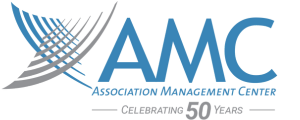
Dealing with Disruption and Competition to the Association Industry – A Q&A With Stephanie Mercado, CAE
On a monthly basis, AMC’s Management Team holds a meeting that includes a generative discussion on a topic of importance to association leaders. This month, the topic focused on competition to the association industry, and the discussion jumped from innovation to risk to Board composition to the speed at which associations make decisions.
Following that discussion, we asked Stephanie Mercado, CAE, who serves as executive director of our client the National Association for Healthcare Quality (NAHQ), to answer a few questions on some of the topics that were discussed.
 AMC: In the discussion, you mentioned that we need to be engaging with people who are on the leading edge to help us get ahead of the competition. Can you talk more about that concept?
AMC: In the discussion, you mentioned that we need to be engaging with people who are on the leading edge to help us get ahead of the competition. Can you talk more about that concept?
Stephanie Mercado: Associations are known for convening people who have shared experiences or interests; there is a natural tendency for people to ‘associate’ with people like themselves though an association. The limitation of bringing like-minded people together is that experiences and perspectives are often similar(ish). Associations are wise to do market research to find out the needs of their constituents, but if we only ask the people who we know about what we know, we can limit our organizational perspective and potential. Exposure to outsiders who can offer market intelligence, in advance of market research, is a thoughtful business practice that helps round out insider thinking. Look for experts in your industry, but outside of your association, to offer fresh insights and perspectives to leverage your organization.
AMC: We all realize that Boards are often restricted by size, meaning that some of the people on the leading edge aren’t able to serve. How can associations build a Board culture that embraces the thoughts and opinions of those who are on the leading edge but not currently serving on the Board?
SM: For-profit boards are very strategic about board composition. They enlist board members based on specific criteria, not just for board service, but to ensure the purpose of the seat is achieved. For example, there may be seats designated for CFO-level talent if the organization is in need of savvy insights related to finance or acquisition. Or, there could be a seat designated for someone who serves as an industry influencer. Often in non-profits, board members are selected based on their commitment to service or to the profession. When this happens, the board is not always strategically balanced to support desired organizational outcomes. If your board is experiencing this, one way to expand thinking is to engage thought leaders. These thought leaders can support the board with one-off insights or could be integrated into the board through a director at-large position. The integration and touchpoints depend on what the board needs and with what frequency.
AMC: What are some of the strategies you are using to be sure you’re getting the insights from thought leaders on a regular basis?
SM: NAHQ leaders and I attend industry events monthly. We attend conferences, seminars and meet with organizational peers to keep our finger on the pulse of the changing healthcare quality environment. When the pace of changes outside of your organization is faster than the pace of change inside your organization, there is a risk of irrelevance. Physically attending events and building relationships with industry leaders keeps NAHQ leadership apprised of industry changes and helps our organization prepare to respond to them. My leaders include me in these meetings because they view me as the tie that binds the ideas and relationships together and because as Executive Director, part of my role is to lead innovation and growth.
AMC: One of the concepts that was mentioned in the discussion was that for-profit competitors aren’t bogged down with the bureaucracy of associations and can bring things to market faster than we can. How can associations counter that?
SM: Associations by nature, and generally by design, move slower than their corporate for-profit counterparts. And, as a result, their growth is slower and impact is potentially lessened. This is particularly threatening when for-profit groups begin competing in space traditionally occupied by non-profits: annual conferences, online learning, content development and curation. A key to gaining a competitive advantage is decreasing time to market on products. Associations that are nimble are working differently and the results are impressive. Here are a few suggestions to decrease time to market:
- Consider making product decisions on a rolling basis so that you are not bound by board meeting dates and annual budget cycles.
- Develop a standardized product/idea evaluation cycle so that when ideas do come in ‘off cycle’ your organization has a predictable process to develop business plans and assess them with limited variability.
- Use standing committees sparingly. Instead, opt for ad hoc work groups to develop products.
- Hire a subject matter expert (SME) from your industry as staff who can help fill in the gaps between staff and volunteers between meetings.
- Implement 90- or 120-day product development cycles.
AMC: Another concept that was mentioned in the discussion is that associations, by their nature, are risk averse. Boards want to make decisions only after seeing all the facts. How can association executives work to create a culture of calculated risk-taking on their Boards, and why is that important?
SM: When things feel uncomfortable, it’s likely that growth and progress are occurring. And, yet, most associations get into an annual rhythm that is predictable, reliable, and safe. Those same associations are often frustrated with the value the organization is offering to members, and may be experiencing declines in membership. Associations (aka association boards) will take on risk when they have confidence that their decision is informed, when the benefits outweigh risks and when they are sure that they have the human resources needed to complete the task and monitor progress into the future. Tools for informed decisions are product/service development processes, business plans and competency assessments. When it comes to taking on risk, the process is more important than the product. Association leaders need to provide a framework for innovation that advances new initiatives, while respecting the need to make innovation predictable, reliable, and safe.
AMC: When thinking about competition for the association industry, are there any other strategies that you use that help you look further ahead than the issues you’re dealing with now (without consulting your crystal ball)?
SM: Association leaders and executive directors have the challenging role of monitoring today and planning for tomorrow. The larger and/or more sophisticated the organization is, the more likely it is that the leadership can focus on tomorrow – middle management will handle the work of today. There are strategies to monitor trends in the industry. These may include keeping up with reading in your trade/profession, connecting frequently with thought leaders, and keeping up with innovations. The two characteristics that are most important for staying at or ahead of industry innovations are discipline and dot-connecting. Discipline is required to keep an eye on the future. It’s much easier to monitor what you manage, but this does not move an organization forward. Also, dot-connecting is key as it is a tool to help leaders identify trends and relationships between concepts. Dot-connecting helps leaders anticipate the future and to plan for it.
AMC: How often are you looking at the disruption and competition for the association industry versus the competition your own association faces? Can/should it happen more often?
SM: Good association leaders focus on managing the association. Great association leaders focus on understanding and leading their trade/profession and apply that to the association to build a better association value proposition.
Stephanie Mercado, CAE, serves as the executive director of the National Association for Healthcare Quality. She can be reached at This email address is being protected from spambots. You need JavaScript enabled to view it.. And if you have any comments on the post, we invite you to take a look and comment on our Linkedin Company Page.
Photo Credit: Speed by snapp3r is licensed under CC BY-ND 2.0.


